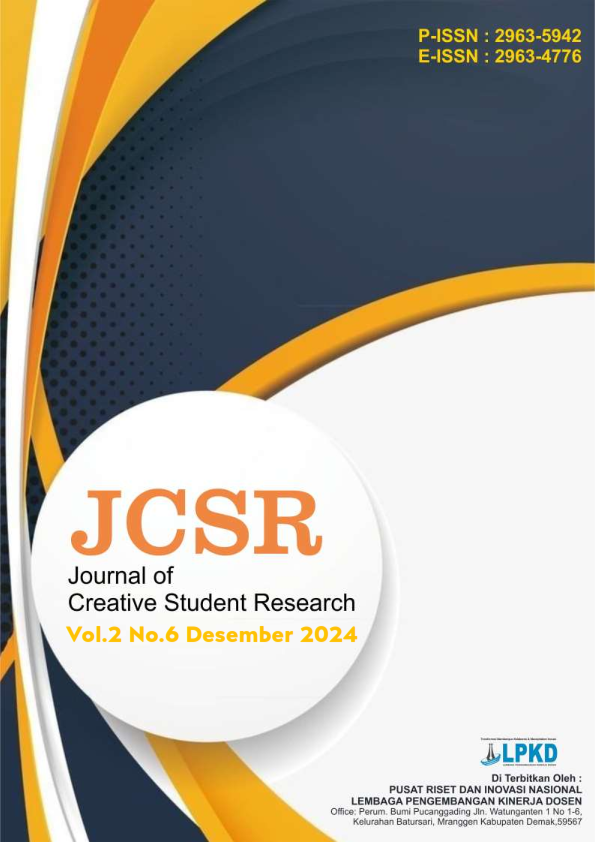Diplomasi Maritim “Rempah” di Nusantara: Perjalanan dari Maluku Sampai ke Pelabuhan Malaka
DOI:
https://doi.org/10.55606/jcsr-politama.v2i6.4571Keywords:
Spice Route, Port of Malacca, Nusantara, Banda, DiplomacyAbstract
Spice commodities are very important commodities in trade in the past, spice trading routes built by the people of the archipelago and traders from India and China, caused many local ports to emerge which developed rapidly into ports that were visited by many merchant ships from various regions, past ports such as Maluku, Banda, Makassar, and Malacca. In the context of global trade, a trade network was formed that connected the western world as consumers and the eastern world as producers of commodities. The regions in the archipelago are known as centers of spice production that are very diverse, almost every region of the archipelago has typical spices that are traded. This study aims to look at the history of the spice route in the archipelago and its benefits as a form of diplomacy in ancient times, which can make the economy in various regions of the archipelago develop well, the spread of religion and cultural exchange can occur due to diplomacy through the spice route. With this aim, this study uses a library research method related to archaeological data and historical source searches. The results of this study obtained information that the most sought-after spices in the past were cloves, nutmeg, and mace, which could be found in the Maluku and Banda regions. From the existence of these three spices, a spice route was created starting from Maluku to the port of Malacca, which at that time was the largest gathering point for Chinese, Indian, and European traders.
Downloads
References
Hanggarini, P., Madjid, M. A., Perwita, A. A., & Wiranto, S. (2022). Budaya Maritim dan Diplomasi Maritim untuk. Indonesian Perspective, 164-179.
Anggrasari, H. (2021). Keunggulan Komparatif dan Kompetitif Rempah-Rempah Indonesia di Pasar Internasional. Jurnal Agrica, 9-19.
Baskoro, R. M. (2022). Kisah Selera dari Negeri Rempah: Memahami Gastrodiplomasi dari Perspektif Indonesia. Indonesian Perspective, 227-249.
Faris, & Bunga. (2022, Juni 11). Aktivitas Laskar Rempah dalam Muhibah Budaya Jalur Rempah 2022. Retrieved from Kemendikbud: https://www.kemdikbud.go.id/main/blog/2022/06/aktivitas-laskar-rempah-dalam-muhibah budaya-jalur-rempah-2022
Issundari, S., & Yani, Y. M. (2021). Implementasi Pembangunan Berkelanjutan Dalam Mengatasi Kemiskinan Melalui Kerja Sama Internasional Daerah. Jurnal Studi Diplomasi dan Keamanan, 103-122.
Khatibah. (2011). Penelitian Kepustakaan. Jurnal Iqra’, 36-39.
Kumala, M. T. (2021). Penguatan Kerja Sama Internasional Dalam Mengurangi Dampak Pandemi Covid-19 Terhadap Sektor Perikanan Di Indonesia. Masalah-Masalah Hukum, 119-130.
Madu, L. (2018). Urgensi Indian Ocean Rim Association (Iora) Dalam Diplomasi Maritim Indonesia. Jurnal of International Studies, 171-187.
Marihandono, D., & Kanumoyoso, B. (2016). Rempah, Jalur Rempah, Dan Dinamika Masyarakat Nusantara. Jakarta: Direktorat Sejarah, Direktorat Jenderal.K.Ebudayaan, Kementertan Pendidikan Dan Kebudayaan.
Mei, Y. (2020). Sustainable Cooperation In International Trade: A Quantitative Analysis. Journal of International Economics, 1-17.
Mière, C. L. (2014). Maritime Diplomacy in the 21st Century. Abingdon: Routledge.
Muslimin, M. F. (2022). Konektivitas Bandar-Bandar Di Jalur Rempah Dalam Novel Arus Balik. Pangadereng : Jurnal Hasil Penelitian Ilmu Sosial dan Humaniora, 59-62.
Rahman, F. (2019). "Negeri Rempah-Rempah" Dari Masa Bersemi Hingga Gugurnya Kejayaan Rempah-Rempah. Patanjala: Journal of Historical and Cultural Research, 347-362.
Razif, & Fauzi. (2017). Jalur Rempah Dan Dinamika Masyarakat Abad X-XVI: Kepulauan Banda, Jambi, Dan Pantai Utara Jawa. Jakarta: Direktorat Sejarah, Direktorat Jenderal Kebudayaan Kementerian Pendidikan dan Kebudayaan.
Ririmasse, M. N. (2017). Sebelum Jalur Rempah: Awal Interaksi Niaga Lintas Batas Di Maluku Dalam Perspektif Arkeologi. Kapata Arkeologi, 47-50.
Rosari, N. A. (2023, Desember 3). Mengenal Jalur Rempah. Retrieved from detikEdu: https://www.detik.com/edu/detikpedia/d-7069359/mengenal-jalur-rempah-nusantara-jejak-perkembangan-peradaban-di-indonesia?utm_source=copy_url&utm_campaign=detikcomsocmed&utm_medium=btn&utm_content=edu
Samarenna, & Lullug, F. (2022). Pendekatan Diplomasi Publik Jalur Rempah sebagai Bagian dari Penciptaan National Branding Indonesia pada Tahun 2020-2022. Universitas Kristen Satya Wacana Institutional Repository, 1-8.
Setiawan, B., & Widiputera, F. (2020). Internalization Strategy of Concious Awareness of Spice Lane as Nation Brand and Nation Pride of Indonesian Nation. Heinonline, 337-342.
Sucahyo, N. (2021, Maret 30). Rempah-Rempah Dan Diplomasi Kuliner Nusantara. Retrieved from VOA Indonesia: https://www.voaindonesia.com/a/rempah-rempah-dan-diplomasi-kuliner-nusantara-/5833556.html
Terkini, B. (2024, Maret 9). Dampak Keberadaan Jalur Rempah dari Sisi Ekonomi dan Budaya. Diambil kembali dari Kumparan: https://kumparan.com/berita-terkini/22JhOpxwX4W?utm_source=Desktop&utm_medium=copy-to-clipboard&shareID=FkrblgBMCpqb
Downloads
Published
How to Cite
Issue
Section
License
Copyright (c) 2024 Journal of Creative Student Research

This work is licensed under a Creative Commons Attribution-ShareAlike 4.0 International License.








